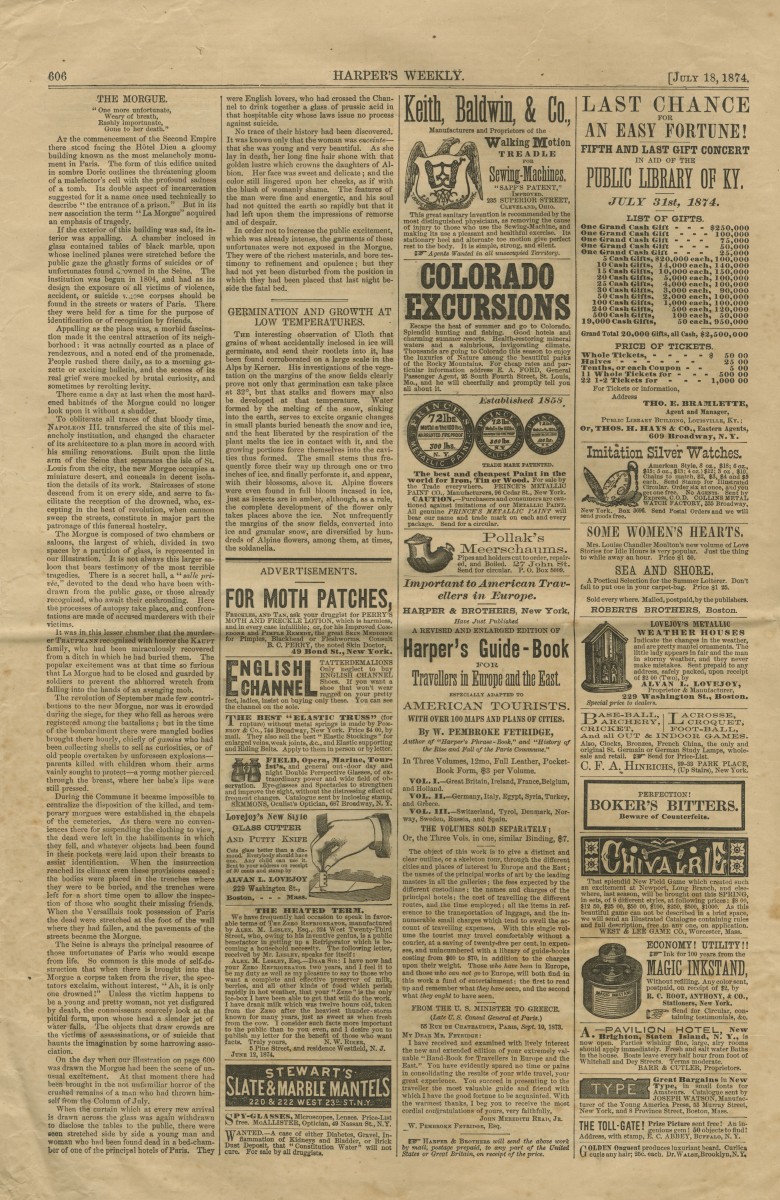-
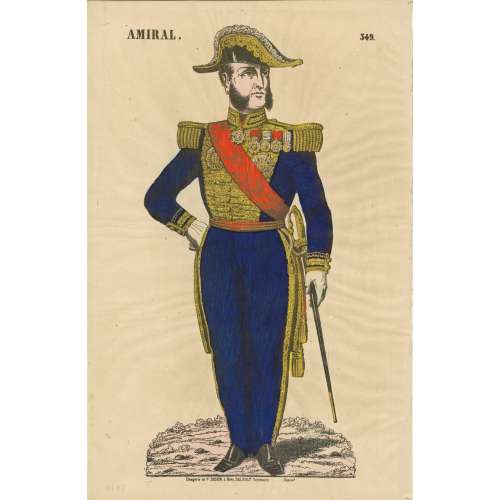 Hand-coloured woodcut on wove paper, 440 x 285 mm; black ink stamp “5049” to reverse. Top left: "AMIRAL"; right: "349". Below: "Imagerie de DIDION, à Metz, DELHALT Successeur." — "Déposé." Paulin Didion (French, 1831 – 1879) – publisher/printer.
Hand-coloured woodcut on wove paper, 440 x 285 mm; black ink stamp “5049” to reverse. Top left: "AMIRAL"; right: "349". Below: "Imagerie de DIDION, à Metz, DELHALT Successeur." — "Déposé." Paulin Didion (French, 1831 – 1879) – publisher/printer. -
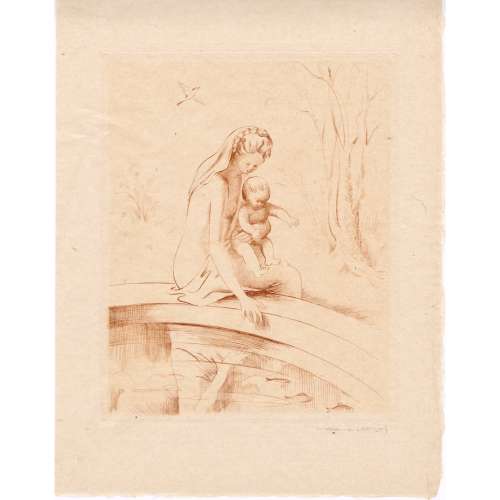 Set of 10 etchings (9 in passe-partout) printed in sanguine on the mother of pearl paper (japon nacre) from the album of 12 prints titled “Jeunesse”, presented by Gérard D'Houville (pen name of Marie de Régnier, née de Heredia) and published by La Tradition in 1945. It was a limited edition of 532 copies, some coloured on Arches paper and some as these set. Plates signed by the artist in pencil below the plate mark. The album cover is missing. Title-page: JEUNESSE | 12 EAUX-FORTES ORIGINALES | DE | MARIANNE CLOUZOT | PRÉSENTÉES | PAR | GÉRARD D'HOUVILLE | {publisher’s device} | LA TRADITION | 1945 || Dimensions: mat 330 x 255 mm; window 225 x 180 mm; sheet 280 x 220 mm; plate 220 x 170 mm. Contributors: Marianne Clouzot (French, 1908 – 2007) – artist Marie de Régnier [Marie de Heredia, Gérard d'Houville] (French, 1875 – 1963) – editor
Set of 10 etchings (9 in passe-partout) printed in sanguine on the mother of pearl paper (japon nacre) from the album of 12 prints titled “Jeunesse”, presented by Gérard D'Houville (pen name of Marie de Régnier, née de Heredia) and published by La Tradition in 1945. It was a limited edition of 532 copies, some coloured on Arches paper and some as these set. Plates signed by the artist in pencil below the plate mark. The album cover is missing. Title-page: JEUNESSE | 12 EAUX-FORTES ORIGINALES | DE | MARIANNE CLOUZOT | PRÉSENTÉES | PAR | GÉRARD D'HOUVILLE | {publisher’s device} | LA TRADITION | 1945 || Dimensions: mat 330 x 255 mm; window 225 x 180 mm; sheet 280 x 220 mm; plate 220 x 170 mm. Contributors: Marianne Clouzot (French, 1908 – 2007) – artist Marie de Régnier [Marie de Heredia, Gérard d'Houville] (French, 1875 – 1963) – editor -
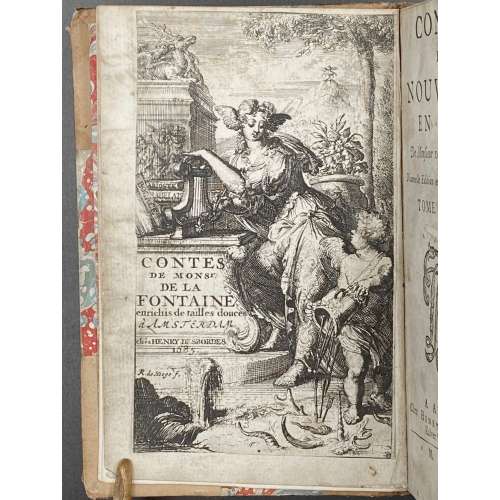 [Jean de LA FONTAINE]. Contes et nouvelles en vers. De Monsieur de La Fontaine. Nouvelle édition enrichie de tailles-douces. À Amsterdam | Chez Henry Desbordes, MDCLXXXV [1685]. — 2 vol. in 1. Pagination: [1] - frontispiece with pasted illustr., [*1] - title p. with blank verso, *2-*5 (only recto numbered) - advertisement, [1] - preface vol. 1, [2] table, 1-236; [6] - preface vol. 2, 1-216, illustr. (in text). Etched frontispiece plate and 58 half-page etchings at the head of each chapter as well as endpiece vignettes, all by R. de Hooge (Romeyn de Hooghe, 1645 – 1708, a Dutch painter, sculptor, engraver and caricaturist. First illustrated edition. "Publication of the scandalous fables was forbidden in France from 1674. According to Van Eeghen, this edition was published without the knowledge of La Fontaine. ...This is the edition with ‘Le Juge de Nêle’ (instead of Mesle) in the contents of the first volume, as well as page 211 for 'Dissertation sur la Joconde'; 16 lines of text on page 211; and 19 lines of text on the first page of the preface of volume 2" [1]. Pott 8vo (15.4 x 10 cm), hardcover; owner's later tan polished half-calf, marbled boards, marbled pastedowns and flyleaves, 5 raised bands, dark brown labels with gilt lettering and gilt roll patterns on spine, tail of the spine slightly damaged. Corners bumped, spotted stains on leather. Henri Desbordes (d. ca. 1722) was a Huguenot printer who was exiled from his business in France and set up as a publisher in Amsterdam in the 17th century.
[Jean de LA FONTAINE]. Contes et nouvelles en vers. De Monsieur de La Fontaine. Nouvelle édition enrichie de tailles-douces. À Amsterdam | Chez Henry Desbordes, MDCLXXXV [1685]. — 2 vol. in 1. Pagination: [1] - frontispiece with pasted illustr., [*1] - title p. with blank verso, *2-*5 (only recto numbered) - advertisement, [1] - preface vol. 1, [2] table, 1-236; [6] - preface vol. 2, 1-216, illustr. (in text). Etched frontispiece plate and 58 half-page etchings at the head of each chapter as well as endpiece vignettes, all by R. de Hooge (Romeyn de Hooghe, 1645 – 1708, a Dutch painter, sculptor, engraver and caricaturist. First illustrated edition. "Publication of the scandalous fables was forbidden in France from 1674. According to Van Eeghen, this edition was published without the knowledge of La Fontaine. ...This is the edition with ‘Le Juge de Nêle’ (instead of Mesle) in the contents of the first volume, as well as page 211 for 'Dissertation sur la Joconde'; 16 lines of text on page 211; and 19 lines of text on the first page of the preface of volume 2" [1]. Pott 8vo (15.4 x 10 cm), hardcover; owner's later tan polished half-calf, marbled boards, marbled pastedowns and flyleaves, 5 raised bands, dark brown labels with gilt lettering and gilt roll patterns on spine, tail of the spine slightly damaged. Corners bumped, spotted stains on leather. Henri Desbordes (d. ca. 1722) was a Huguenot printer who was exiled from his business in France and set up as a publisher in Amsterdam in the 17th century. -
![George Cruikshank. George Cruikshank's Fairy Library. Hop-O'-My Thumb. Jack and the Bean-Stalk. Cinderella. Puss in Boots. — London: George Bell and Sons, 1885. — pp.: [2] blank, [2] first half-title with blank verso, [i-ii] second half-title with blank verso, [2] frontispiece plate with blank recto, [iii-viii] title, colophone, editor's note, list of illustr. [2] title with blank verso, [1] 2-101 [3] blank, 24 plates with protective tissue, unpag. — Colophon: This edition is limited to 500 copies, with India paper impressions. The former editions have been from lithographic transfers. The plates were retouched under Mr. Cruikshank's direction shortly before his death, and have not been used since until now.](https://varshavskycollection.com/wp-content/uploads/2021/02/LIB-2454.2020-f-1-500x500.jpeg) Title: GEORGE CRUIKSHANK'S FAIRY LIBRARY. | HOP-O'-MY THUMB. | JACK AND THE BEAN-STALK. | CINDERELLA. | PUSS IN BOOTS. | [DEVICE] | LONDON: | GEORGE BELL AND SONS, YORK STREET, COVENT GARDEN. Pagination: [2] – blanks, [2] – first half-title with blank verso, [i-ii] – second half-title with blank verso, [2] – blank / frontispiece, [iii-viii] title, colophon, editor's note, list of illustrations, [2] – title with blank verso, [1] 2-101 [3] – blank; 24 plates with protective tissue. Colophon: This edition is limited to 500 copies, with India paper impressions. The former editions have been from lithographic transfers. The plates were retouched under Mr. Cruikshank's direction shortly before his death, and have not been used since until now. Binding: 4to, 22.2 x 17.5 cm, hardcover; 3/4 black calf ruled in gilt, brown calf spine with raised bands decorated in gilt, with gilt title lettering. Green marbled boards and end-papers. Abel E. Berland's bookplate pasted to front pastedown. Professionally rebound, re-backed with the original spine laid down, corners bumped. Catalogue Raisonné: Not in Alan M. Cohen's. As writes the British Library: "George Cruikshank’s [...] illustrations for the first English translation of Grimm’s Fairy Tales were praised widely, but his own rewriting of fairytales was criticised, most prominently by Charles Dickens. This was not due to the quality of the illustrations, but because, in line with his temperance beliefs, Cruikshank rewrote aspects of the fairytales to warn the reader against the evils of alcohol. Thus, for instance, the preparations for Cinderella’s marriage include the court throwing all alcohol in the palace on a bonfire; and in ‘Jack and the Beanstalk’, the giant is an alcoholic. Dickens, a friend of Cruikshank, was outraged at what he considered to be a betrayal of the essence of fairytales and, in protest, he published an essay in his weekly magazine Household Words entitled ‘Frauds on the Fairies’ in protest (1853)."
Title: GEORGE CRUIKSHANK'S FAIRY LIBRARY. | HOP-O'-MY THUMB. | JACK AND THE BEAN-STALK. | CINDERELLA. | PUSS IN BOOTS. | [DEVICE] | LONDON: | GEORGE BELL AND SONS, YORK STREET, COVENT GARDEN. Pagination: [2] – blanks, [2] – first half-title with blank verso, [i-ii] – second half-title with blank verso, [2] – blank / frontispiece, [iii-viii] title, colophon, editor's note, list of illustrations, [2] – title with blank verso, [1] 2-101 [3] – blank; 24 plates with protective tissue. Colophon: This edition is limited to 500 copies, with India paper impressions. The former editions have been from lithographic transfers. The plates were retouched under Mr. Cruikshank's direction shortly before his death, and have not been used since until now. Binding: 4to, 22.2 x 17.5 cm, hardcover; 3/4 black calf ruled in gilt, brown calf spine with raised bands decorated in gilt, with gilt title lettering. Green marbled boards and end-papers. Abel E. Berland's bookplate pasted to front pastedown. Professionally rebound, re-backed with the original spine laid down, corners bumped. Catalogue Raisonné: Not in Alan M. Cohen's. As writes the British Library: "George Cruikshank’s [...] illustrations for the first English translation of Grimm’s Fairy Tales were praised widely, but his own rewriting of fairytales was criticised, most prominently by Charles Dickens. This was not due to the quality of the illustrations, but because, in line with his temperance beliefs, Cruikshank rewrote aspects of the fairytales to warn the reader against the evils of alcohol. Thus, for instance, the preparations for Cinderella’s marriage include the court throwing all alcohol in the palace on a bonfire; and in ‘Jack and the Beanstalk’, the giant is an alcoholic. Dickens, a friend of Cruikshank, was outraged at what he considered to be a betrayal of the essence of fairytales and, in protest, he published an essay in his weekly magazine Household Words entitled ‘Frauds on the Fairies’ in protest (1853)." -
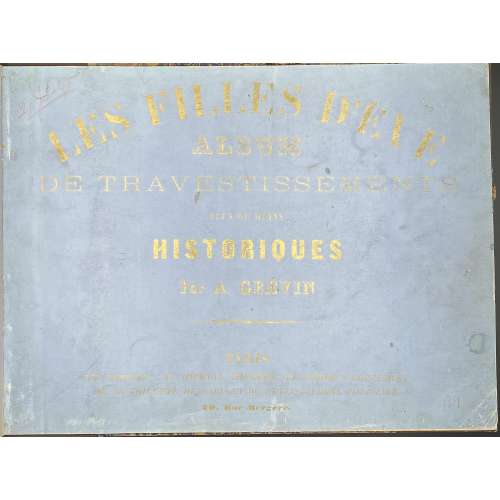 Pictorial album of 20 hand-coloured wood engravings by Firmin Gillot after Alfred Grévin; numbered 1 to 20, bound with tissue guards in half-brown cloth over marbled boards, publisher's gilt-lettered blue wrappers preserved, purple-blueish endpapers. Front wrapper (gilt on blue): LES FILLES D'EVE | ALBUM | DE TRAVESTISSEMENTS | PLUS OU MOINS | HISTORIQUES | Par A. GRÉVIN | — | PARIS | AUX BUREAUX : DU JOURNAL AMUSANT, DES MODES PARISIENNES | DE LA TOILETTE DE PARIS ET DU PETIT JOURNAL POUR RIRE | 20. Rue Bergère. || ; Henri Plon's imprint to back wrapper. Contributors: Grevin, Alfred (French, 1827 – 1892) Gillot, Firmin (French, 1820 – 1872) Plon, Henri (French, 1806 – 1872) Ref.: Metropoliten Museum.
Pictorial album of 20 hand-coloured wood engravings by Firmin Gillot after Alfred Grévin; numbered 1 to 20, bound with tissue guards in half-brown cloth over marbled boards, publisher's gilt-lettered blue wrappers preserved, purple-blueish endpapers. Front wrapper (gilt on blue): LES FILLES D'EVE | ALBUM | DE TRAVESTISSEMENTS | PLUS OU MOINS | HISTORIQUES | Par A. GRÉVIN | — | PARIS | AUX BUREAUX : DU JOURNAL AMUSANT, DES MODES PARISIENNES | DE LA TOILETTE DE PARIS ET DU PETIT JOURNAL POUR RIRE | 20. Rue Bergère. || ; Henri Plon's imprint to back wrapper. Contributors: Grevin, Alfred (French, 1827 – 1892) Gillot, Firmin (French, 1820 – 1872) Plon, Henri (French, 1806 – 1872) Ref.: Metropoliten Museum. -
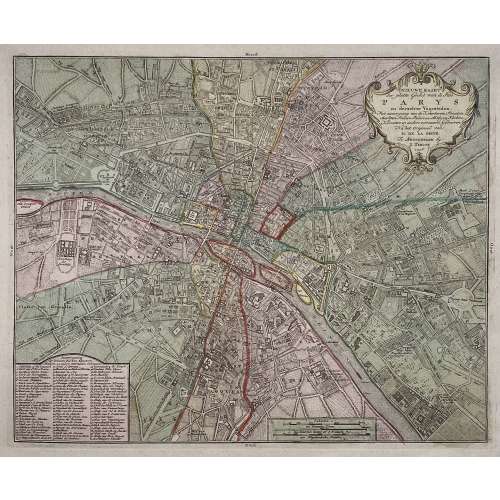
Title: NIEUWE KAART | der platte Grond van de Stad | PARYS | en derzelver Voorsteden. | Met aanwyzing van de Kwartieren, Staaten, | Markten, Pleinen, Paleizen, Abtyden, Kerken, | Kloosters en andere voornaame Gebouwen. | Na het Origineel van | M. DE LA GRIVE. | Te Amsterdam by | I. Tirion. | 1756. ||
Author : Jean Delagrive (French, 1689-1757)
Publisher: Isaak Tirion (Dutch, 1705 – 1765)
Publication date: 1756.
Dimensions: Sheet: 42.5 x 53.8 cm; Image: 30.7 x 37.7 cm.
Plate № 59 from Beknopte Atlas van omtrent honderd platte gronden der voornaamste vestingen, kasteelen en Steden van Europa. -
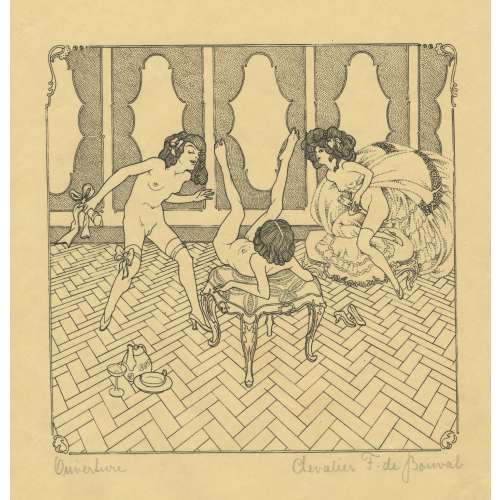 A set of sixteen planographic prints, signed and titled in pencil by owner “Chevalier F. de Bouval” (pseudonym of Franz von Bayros (Austrian, 1866 – 1924). Titles include: 1) Ouverture, 2) champagne brut, 3) maternité, 4) piano, 5) crudité délicieuse, 6. la belle vue, 7) au pensionnat, 8) le collier, 9) languelles pénètrelles, 10) introduction, 11) le sourrogat, 12) variation amoureuse, 13) la surprise, 14) le clef délicat, 15) le monstre gomme, 16) fruits de sud. Printed on wove paper, possibly engraved on wood after ink drawings by Franz von Bayros (Austrian, 1866 – 1924) under the pseudonym Chevalier F. de Bouval. Size: sheet 30 x 24 cm, image 18 x 17.5 cm. In another source, there are two more images from the same set: le passe-partout and la doublette, making 18 images altogether; the set is titled “Lesbia: XVIII sujets”, signed by Chevalier François René de Bouval.
A set of sixteen planographic prints, signed and titled in pencil by owner “Chevalier F. de Bouval” (pseudonym of Franz von Bayros (Austrian, 1866 – 1924). Titles include: 1) Ouverture, 2) champagne brut, 3) maternité, 4) piano, 5) crudité délicieuse, 6. la belle vue, 7) au pensionnat, 8) le collier, 9) languelles pénètrelles, 10) introduction, 11) le sourrogat, 12) variation amoureuse, 13) la surprise, 14) le clef délicat, 15) le monstre gomme, 16) fruits de sud. Printed on wove paper, possibly engraved on wood after ink drawings by Franz von Bayros (Austrian, 1866 – 1924) under the pseudonym Chevalier F. de Bouval. Size: sheet 30 x 24 cm, image 18 x 17.5 cm. In another source, there are two more images from the same set: le passe-partout and la doublette, making 18 images altogether; the set is titled “Lesbia: XVIII sujets”, signed by Chevalier François René de Bouval. -
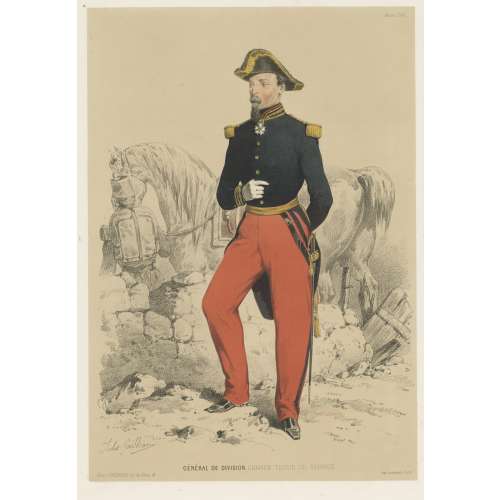 Chromolithography on thick wove paper, 473 x 315 mm sheet, 372 x 260 mm image, black ink stamp “5050” to reverse. Signed on stone "Jules Gaildrau"; below centre: "GÉNERAL DE DIVISION, GRANDE TENUE DE SERVICE"; Bottom left: "Paris, J. Gaildrau, rue de Seine, 16"; right: "Imp. Lemercier, Paris." Joseph Lemercier (French, 1803 – 1887) – printer. Jules Gaildrau (French, 1816 – 1898) – artist.
Chromolithography on thick wove paper, 473 x 315 mm sheet, 372 x 260 mm image, black ink stamp “5050” to reverse. Signed on stone "Jules Gaildrau"; below centre: "GÉNERAL DE DIVISION, GRANDE TENUE DE SERVICE"; Bottom left: "Paris, J. Gaildrau, rue de Seine, 16"; right: "Imp. Lemercier, Paris." Joseph Lemercier (French, 1803 – 1887) – printer. Jules Gaildrau (French, 1816 – 1898) – artist. -
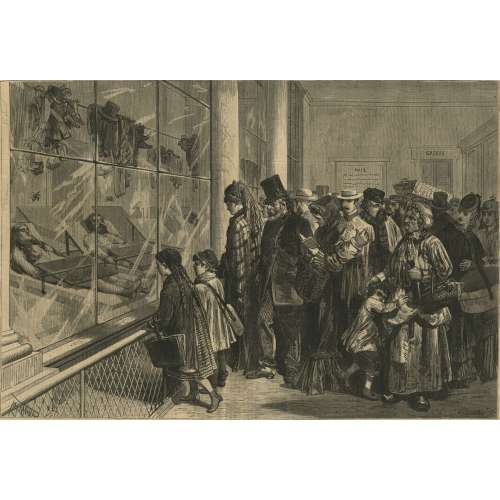
-
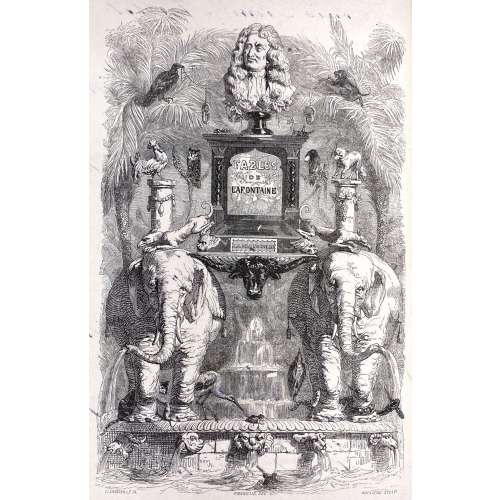 Fables de La Fontaine / édition illustrée par J. J. Grandville (in 2 volumes). – Paris: H. Fournier Ainé, Perronin, 1838. Imp. H. Fournier et Ce, 14 rue de Seine (Premier Tirage). Vol 1: [2 - ht, imprim.] [2 - blank with handwritten inscription, frontis.] [2 - t.p., blank], [ [i] ii-xxviii - épitre, préface, [2 - plate 'fables', [1] 2 - dedication, [3, 4 - pltate: livre 1, blank] [5, 6 - plate: blank, cigale] [7] 8 - fab.1 (the subsequent plates are not paginated) - 292. (245-246 - Avertissement), (247-248 - A mamdam de Montespan); Wood engravings: frontispiece + half-title Fables + 7 running half-titles Livres des Fables + 72 plates. Vol. 2: [2 - ht, imprim.] [2 - t.p., blank] [1, 2 - plate 'livre 8', blank] [3] 4-312 (191-192 épilogue), (195-196 Au duc de Bourgogne), (268 - fin des fables), (269-296 Philemon et Baucis | D. O. M. | La Martone Déphèse | Belphegor), (297 -308 notice), (309-312 table); Wood engravings: 5 running half-titles Livres des Fables + 1 half-title Philemon et Baucis + 48 plates. Size: 8vo, 23.2 x 15 cm. Binding: Full tree-calf, flat spine stamped with gilt, red and brown labels with gilt lettering, marbled endpapers. Handwritten nut ink inscription to blank recto of frontispiece: the history of Millet-Fontaine family (provenance?) There were two print-runs in the year 1838. According to Léopold Carteret (Le trésor du bibliophile. Epoque romantique. 1801-1875 / Livres illustrés du XIXe siècle. – Paris: L. Carteret; imprim. Lahure, 1927, pp. 357-9), the first run (Premier Tirage) published by H. Fournier and Perrotin, while the Second Tirage by H. Fournier Ainé. Though, the initial cap character "N" at p. xiii (vie d'Ésope) in this copy is formed by 'faite de lignes bouclées' as in the first print-run, rather than by 'petits carreaux noirs et blances' as in the second. We can conclude with confidence that this copy belongs to Premier Tirage.
Fables de La Fontaine / édition illustrée par J. J. Grandville (in 2 volumes). – Paris: H. Fournier Ainé, Perronin, 1838. Imp. H. Fournier et Ce, 14 rue de Seine (Premier Tirage). Vol 1: [2 - ht, imprim.] [2 - blank with handwritten inscription, frontis.] [2 - t.p., blank], [ [i] ii-xxviii - épitre, préface, [2 - plate 'fables', [1] 2 - dedication, [3, 4 - pltate: livre 1, blank] [5, 6 - plate: blank, cigale] [7] 8 - fab.1 (the subsequent plates are not paginated) - 292. (245-246 - Avertissement), (247-248 - A mamdam de Montespan); Wood engravings: frontispiece + half-title Fables + 7 running half-titles Livres des Fables + 72 plates. Vol. 2: [2 - ht, imprim.] [2 - t.p., blank] [1, 2 - plate 'livre 8', blank] [3] 4-312 (191-192 épilogue), (195-196 Au duc de Bourgogne), (268 - fin des fables), (269-296 Philemon et Baucis | D. O. M. | La Martone Déphèse | Belphegor), (297 -308 notice), (309-312 table); Wood engravings: 5 running half-titles Livres des Fables + 1 half-title Philemon et Baucis + 48 plates. Size: 8vo, 23.2 x 15 cm. Binding: Full tree-calf, flat spine stamped with gilt, red and brown labels with gilt lettering, marbled endpapers. Handwritten nut ink inscription to blank recto of frontispiece: the history of Millet-Fontaine family (provenance?) There were two print-runs in the year 1838. According to Léopold Carteret (Le trésor du bibliophile. Epoque romantique. 1801-1875 / Livres illustrés du XIXe siècle. – Paris: L. Carteret; imprim. Lahure, 1927, pp. 357-9), the first run (Premier Tirage) published by H. Fournier and Perrotin, while the Second Tirage by H. Fournier Ainé. Though, the initial cap character "N" at p. xiii (vie d'Ésope) in this copy is formed by 'faite de lignes bouclées' as in the first print-run, rather than by 'petits carreaux noirs et blances' as in the second. We can conclude with confidence that this copy belongs to Premier Tirage.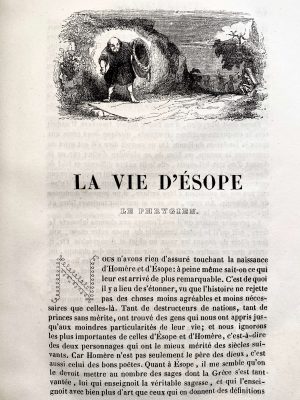 Wood engravings (135 plates, including frontispiece, and numerous headpieces and initial letters) were cut by the following artists (the first number is the number of the chapter ('livre'), the second – the number of the fable within the 'livre':
Wood engravers:
John Bastin, (British, fl. 1840 – 1850): 6-6, 7-13, and 8-9.
Alexandre Belhatte (French, born in 1811): 3-11 and chapter title pages to 'livres' 6, 11, 12, headpices on p. 117 in vol. 2, and 'Philemon et Baucis' section title page.
J. Constantine Beneworth (active France, 19th century): 1-6.
Louis-Henri Brévière (French, 1797 – 1869): 1-10, 2-7, 6-10, 6-21, 7-4, 8-10, 8-27, 9-3, 10-4, 12-11, frontispice, together with François-Louis Français (French, 1814–1897), and 'Fin des fables' tailpiece.
Brévière et Hébert: Louis-Henri Brévière (French, 1797 – 1869) and César-Auguste Hébert (French, active 19th century): 1-1, 1-2, 1-13, 1-18, 2-2, 2-11, 3-1, 3-3, 3-4, 3-18, 4-20, 4-21, 4-22, 5-5, 5-20, 6-2, 6-8, 7-3, 8-7, 8-12, 8-14, 8-17, 9-14, 10-6, 10-16, 11-6, 12-4, 12-25.
Joseph-Hippolyte-Jules Caqué (French, 1814 – 1885): 7-11 and headpieces on p. 251 in vol. 1 and on p. 197 in vol. 2.
Prosper-Adolphe-Léon Cherrier (French, born 1806): 8-6.
Henry Isidore Chevauchet (French, fl. 1837 – 1850): 1-19, 2-4, and 4-5.
Louis Dujardin (French, 1808 – 1859): 10-9.
Pierre-François Godard (French, 1768 – 1838): 1-5, 1-16, 5-2, and 10-11.
Charles David Laing (British, fl. 1836 – 1853): 7-9.
Lacoste père et fils aîné et Auguste-Alexandre Guillaumot (French, 1815 – 1892): 1-4, 1-20, 9-17, and 11-5.
Laisné (Alfred, Adèle, and Aglaé) (French, active 1835–1868): 5-8, 6-5, 6-17, 8-2, 8-15, 9-9, 9-10, 11-1, 11-8, 12-10.
(Alfred, Adèle, and Aglaé) Laisné (French, active 1835–1868): 5-8, 6-5, 6-17, 8-2, 8-15, 9-9, 9-10, 11-1, 11-8, 12-10.
Théodore Maurisset (French, fl. 1834 – 1859): 2-14 and 6-13.
Antoine-Alphée Piaud (French, 1813 – 1867): 1-17, 2-9, 2-16, 4-1, 4-4, 5-15, 5-17, 5-18, 5-21, 8-22, 8-23, 8-25, 9-19, 10-13, 11-3, 11-9, 12-13, 12-15, 12-21, three 'livres': 3, 9, 10, and headpiece on p. 71 in vol. 2.
Roux-Jourdain: Two 'livre' title pages, 1 and 2.
John Orrin Smith (British, 1799 – 1843): 2-13, 2-18, 3-9, 3-14, 4-9, and 4-14.L. Chauchefoin (French): 2-3 and 5.13.
Matthew Urlwin Sears (British, 1799 – 1870): 10-1 and 12-9.
Monogram TM or MT (possibly for Théodore Maurisset): 6-16 and 10-3.
Monogram GO–> (possibly for Godard) : 5-3, 7-1, and 9-5.
Monogram B and BV: 4-11, 12-6, 'livre' 4, and headpieces on p. 1 in vol. 1 and on p. 167 in vol. 2.
Unsigned or with an illegible signature: "fables' section title, 1-3, 1-9, 3-5, 3-8, 4-15, 4-18, 5-10, 7-7, 7-16, 9-2, 9-4, 12-2, 12-3, 12-17, and two 'livre' title pages, 5 and 8.
Little is know about Matthew Urlwin Sears. He was a wood engraver of good reputation who is known to have worked in London in the early 1820s, Paris and Leipzig. Listed as "wood engraver" on records of the UK Printing Historical Society. Work The British Museum owns three of his earliest published works, engravings for Northcote's Fables (1828). He authored "Specimen of stereotype ornaments, 1825" which was reprinted as a facsimile in 1990 by the Printing Historical Society (London), with a foreword by James Mosley. He is mentioned by Pierre Gusman in "La Gravure sur Bois en France" (Paris, 1929). Laurent's Histoire de l'Empereur Napoleon, (1839) is one of many publications on which both Sears and his partner John Quartly worked, as well as numerous other engravers. His work appeared in "Aunt Effie's Rhymes" (1852) and "Uncle Tom's Cabin", by Harriet Beech Stowe (Edinburgh: Adam and Charles Black, 1853) [Claire-Juliette Beale, December 2009].
Wood engravings (135 plates, including frontispiece, and numerous headpieces and initial letters) were cut by the following artists (the first number is the number of the chapter ('livre'), the second – the number of the fable within the 'livre':
Wood engravers:
John Bastin, (British, fl. 1840 – 1850): 6-6, 7-13, and 8-9.
Alexandre Belhatte (French, born in 1811): 3-11 and chapter title pages to 'livres' 6, 11, 12, headpices on p. 117 in vol. 2, and 'Philemon et Baucis' section title page.
J. Constantine Beneworth (active France, 19th century): 1-6.
Louis-Henri Brévière (French, 1797 – 1869): 1-10, 2-7, 6-10, 6-21, 7-4, 8-10, 8-27, 9-3, 10-4, 12-11, frontispice, together with François-Louis Français (French, 1814–1897), and 'Fin des fables' tailpiece.
Brévière et Hébert: Louis-Henri Brévière (French, 1797 – 1869) and César-Auguste Hébert (French, active 19th century): 1-1, 1-2, 1-13, 1-18, 2-2, 2-11, 3-1, 3-3, 3-4, 3-18, 4-20, 4-21, 4-22, 5-5, 5-20, 6-2, 6-8, 7-3, 8-7, 8-12, 8-14, 8-17, 9-14, 10-6, 10-16, 11-6, 12-4, 12-25.
Joseph-Hippolyte-Jules Caqué (French, 1814 – 1885): 7-11 and headpieces on p. 251 in vol. 1 and on p. 197 in vol. 2.
Prosper-Adolphe-Léon Cherrier (French, born 1806): 8-6.
Henry Isidore Chevauchet (French, fl. 1837 – 1850): 1-19, 2-4, and 4-5.
Louis Dujardin (French, 1808 – 1859): 10-9.
Pierre-François Godard (French, 1768 – 1838): 1-5, 1-16, 5-2, and 10-11.
Charles David Laing (British, fl. 1836 – 1853): 7-9.
Lacoste père et fils aîné et Auguste-Alexandre Guillaumot (French, 1815 – 1892): 1-4, 1-20, 9-17, and 11-5.
Laisné (Alfred, Adèle, and Aglaé) (French, active 1835–1868): 5-8, 6-5, 6-17, 8-2, 8-15, 9-9, 9-10, 11-1, 11-8, 12-10.
(Alfred, Adèle, and Aglaé) Laisné (French, active 1835–1868): 5-8, 6-5, 6-17, 8-2, 8-15, 9-9, 9-10, 11-1, 11-8, 12-10.
Théodore Maurisset (French, fl. 1834 – 1859): 2-14 and 6-13.
Antoine-Alphée Piaud (French, 1813 – 1867): 1-17, 2-9, 2-16, 4-1, 4-4, 5-15, 5-17, 5-18, 5-21, 8-22, 8-23, 8-25, 9-19, 10-13, 11-3, 11-9, 12-13, 12-15, 12-21, three 'livres': 3, 9, 10, and headpiece on p. 71 in vol. 2.
Roux-Jourdain: Two 'livre' title pages, 1 and 2.
John Orrin Smith (British, 1799 – 1843): 2-13, 2-18, 3-9, 3-14, 4-9, and 4-14.L. Chauchefoin (French): 2-3 and 5.13.
Matthew Urlwin Sears (British, 1799 – 1870): 10-1 and 12-9.
Monogram TM or MT (possibly for Théodore Maurisset): 6-16 and 10-3.
Monogram GO–> (possibly for Godard) : 5-3, 7-1, and 9-5.
Monogram B and BV: 4-11, 12-6, 'livre' 4, and headpieces on p. 1 in vol. 1 and on p. 167 in vol. 2.
Unsigned or with an illegible signature: "fables' section title, 1-3, 1-9, 3-5, 3-8, 4-15, 4-18, 5-10, 7-7, 7-16, 9-2, 9-4, 12-2, 12-3, 12-17, and two 'livre' title pages, 5 and 8.
Little is know about Matthew Urlwin Sears. He was a wood engraver of good reputation who is known to have worked in London in the early 1820s, Paris and Leipzig. Listed as "wood engraver" on records of the UK Printing Historical Society. Work The British Museum owns three of his earliest published works, engravings for Northcote's Fables (1828). He authored "Specimen of stereotype ornaments, 1825" which was reprinted as a facsimile in 1990 by the Printing Historical Society (London), with a foreword by James Mosley. He is mentioned by Pierre Gusman in "La Gravure sur Bois en France" (Paris, 1929). Laurent's Histoire de l'Empereur Napoleon, (1839) is one of many publications on which both Sears and his partner John Quartly worked, as well as numerous other engravers. His work appeared in "Aunt Effie's Rhymes" (1852) and "Uncle Tom's Cabin", by Harriet Beech Stowe (Edinburgh: Adam and Charles Black, 1853) [Claire-Juliette Beale, December 2009]. -
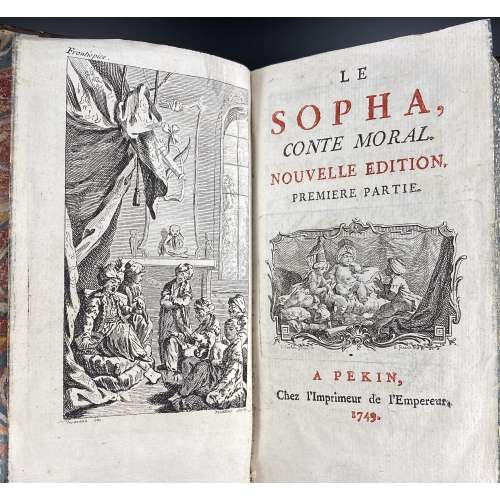 Title-page in black and red: LE | SOPHA, | CONTE MORAL. | NOUVELLE EDITION. | PREMIERE PARTIE. | {vignette} | A PEKIN, | Chez l'imprimeur de l'Empereur, | 1749. || Pagination: Two volumes in one. [2] – blanks, [2] – blank / frontis., [i, ii] – t.p. / blank, [iii] iv-xxi [xxii] ; [1] 2-253, [254-256] – table / blank, [2] – blanks; [i, ii] f.t. (seconde partie). [iii] 4-237 [238-240] – table / blank, [2] – blanks ; ills. 1 frontispiece, 4 plates and 2 vignettes by Pelletier after Clavereau, 2 fleurons by Fessard after Cochin. Collation: 12mo; a12, A8B4–T8V4, X8 [*1]; A8B4–T8V4. Binding: Full mottled calf, flat spine, compartments double-ruled in gilt, gilt flowers and foliage in compartments, crimson title label; marbled endpapers. Printed on laid paper, watermarked. Size: 14.8 x 8.8 cm Catalogue raisonné: Cohen, de Ricci (266); J. Lewine (124-5).
Title-page in black and red: LE | SOPHA, | CONTE MORAL. | NOUVELLE EDITION. | PREMIERE PARTIE. | {vignette} | A PEKIN, | Chez l'imprimeur de l'Empereur, | 1749. || Pagination: Two volumes in one. [2] – blanks, [2] – blank / frontis., [i, ii] – t.p. / blank, [iii] iv-xxi [xxii] ; [1] 2-253, [254-256] – table / blank, [2] – blanks; [i, ii] f.t. (seconde partie). [iii] 4-237 [238-240] – table / blank, [2] – blanks ; ills. 1 frontispiece, 4 plates and 2 vignettes by Pelletier after Clavereau, 2 fleurons by Fessard after Cochin. Collation: 12mo; a12, A8B4–T8V4, X8 [*1]; A8B4–T8V4. Binding: Full mottled calf, flat spine, compartments double-ruled in gilt, gilt flowers and foliage in compartments, crimson title label; marbled endpapers. Printed on laid paper, watermarked. Size: 14.8 x 8.8 cm Catalogue raisonné: Cohen, de Ricci (266); J. Lewine (124-5). -
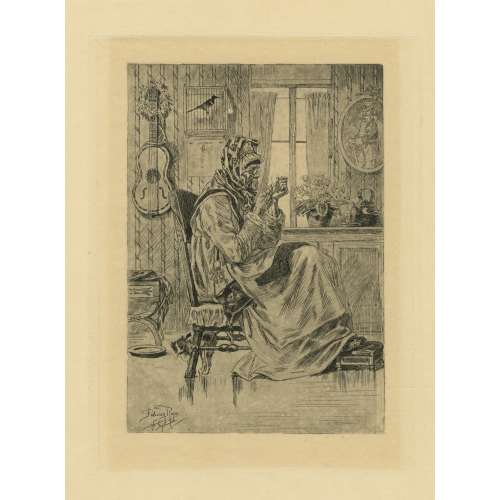
Etching on wove paper, depicting an old woman trying to thread a needle. Signed in plate: "Felicien Rops, 76 Septembre". Owner's stamp LvM on verso.
Dimensions: Paper: 51.9 x 35 cm; Plate: 27.5 x 21 cm; Image: 23.5 x 16 cm.
Catalogue raisonné: Arthur Hubschmid (1977): 358; Graphics irreverent and erotic (1968): 54.
-
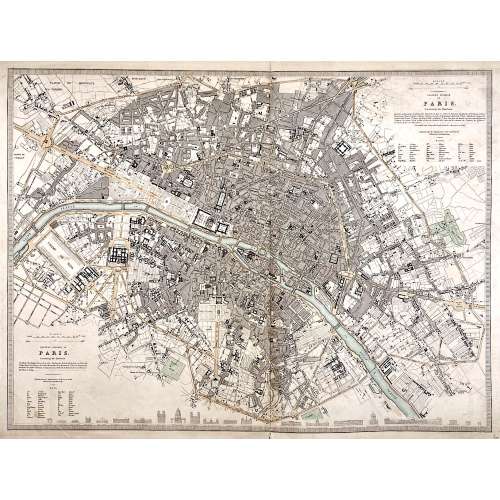 Top right: EASTERN DIVISION OF | PARIS. | Containing the Quartiers | {5 lines in italic} | Published under the Superintendence of the Society for the | Diffusion of Useful Knowledge || Bottom left: WESTERN DIVISION OF | PARIS. | Containing the Quartiers | {4 lines in italic} | Published under the Superintendence of the Society for the | Diffusion of Useful Knowledge || The map is framed, but there is no lettering beneath the frame to identify the cartographer, engraver, and publisher. However, we can attribute it to William Barnard Clarke (British, 1806 – 1865) and John Shury (fl. c. 1814-1844). The publisher is either Baldwin & Cradock or Chapman and Hall. Dimensions: Sheet: 40 x 60.8 cm; Image: 40 x 53.5 cm.
Top right: EASTERN DIVISION OF | PARIS. | Containing the Quartiers | {5 lines in italic} | Published under the Superintendence of the Society for the | Diffusion of Useful Knowledge || Bottom left: WESTERN DIVISION OF | PARIS. | Containing the Quartiers | {4 lines in italic} | Published under the Superintendence of the Society for the | Diffusion of Useful Knowledge || The map is framed, but there is no lettering beneath the frame to identify the cartographer, engraver, and publisher. However, we can attribute it to William Barnard Clarke (British, 1806 – 1865) and John Shury (fl. c. 1814-1844). The publisher is either Baldwin & Cradock or Chapman and Hall. Dimensions: Sheet: 40 x 60.8 cm; Image: 40 x 53.5 cm. -
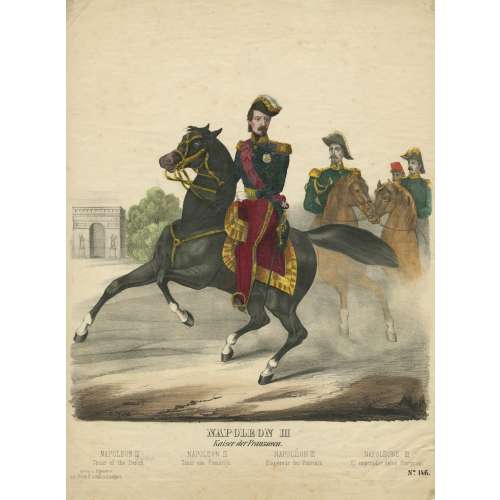 Hand-coloured lithography on wove paper 423 x 332 mm; On reverse: black ink stamp “4956”, ms “A”, ms pencil “428” and “Ernest”. Under the image, centre: "NAPOLEON III | Kaiser der Franzosen." Velow: | NAPOLEON III | Czaar of the French — NAPOLEON III | Czaar van Frankrijk — NAPOLÉON III | Empereur des Francais. — NAPOLEONE III | El emperador delos Franceses; bottom left: "Verlag u. Eigenthum | von. Fried. G. Schulz in Stuttgart.", right: "No 146." The artist's and printer's names in stone are not legible. Published in Stuttgart by Friederich Gustav Schulz (German, 1786 – 1859) during the time of the Second French Empire (1852-1870).
Hand-coloured lithography on wove paper 423 x 332 mm; On reverse: black ink stamp “4956”, ms “A”, ms pencil “428” and “Ernest”. Under the image, centre: "NAPOLEON III | Kaiser der Franzosen." Velow: | NAPOLEON III | Czaar of the French — NAPOLEON III | Czaar van Frankrijk — NAPOLÉON III | Empereur des Francais. — NAPOLEONE III | El emperador delos Franceses; bottom left: "Verlag u. Eigenthum | von. Fried. G. Schulz in Stuttgart.", right: "No 146." The artist's and printer's names in stone are not legible. Published in Stuttgart by Friederich Gustav Schulz (German, 1786 – 1859) during the time of the Second French Empire (1852-1870). -
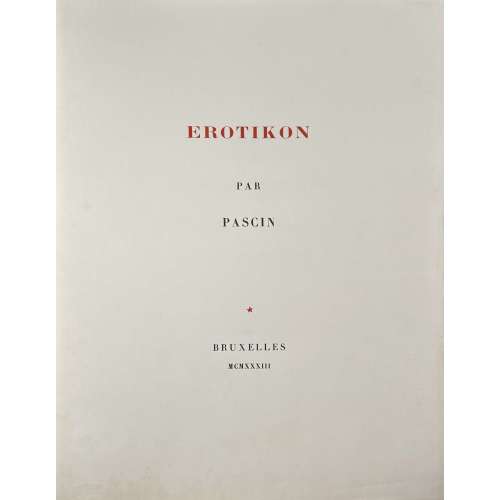 A portfolio of nine heliogravures after Jules Pascin. Cloth-backed cardboard portfolio 420 x 335 mm with 9 heliogravures on slightly tinted india paper, each numbered in pencil and mounted into a passe-partout 410 x 318 mm. Copy № 25 out of 40 printed on india (chine) paper. Copy № 25 of 40. Title (red and black): EROTIKON | PAR | PASCIN | ★ | BRUXELLES | MCMXXXIII || Limitation: CET | ALBUM | A ÉTÉ TIRÉ | A | QUARANTE ET UN EXEMPLAIRES | NUMÉROTÉS | DONT | UN EX. SUR PAPIER ANCIEN | & | QUARANTE EX. SUR CHINE | No (ms 25/40) || Catalogue raisonné: Dutel III № 1498. Seller's description:Neun Heliogravüren. 1933. Meist ca. 30 : 35 cm. Nummeriert. Exemplar 25/40 (Gesamtauflage 41). – Die Heliogravüren auf leicht getöntem China, jedes Blatt mit Bleistift nummeriert und in Passepartouts montiert. – Die neun Passepartouts eingelegt in zwei Büttenumschläge, einer mit Titel und dem nummerierten Auflagenvermerk, der zweite unbedruckt, ferner Büttenumschlag mit Titel in Rotdruck und Halbleinenchemise. – Die Heliogravüren erschienen 1933, drei Jahre nach Pascins Tod bei Daragnes in Paris mit der fingierten Angabe »Brüssel«. – Das berühmte Mappenwerk bildet eine der großen Seltenheiten der erotischen Kunst. Die Motive Pascins beschreibt das Bilderlexikon als »eine Art ›Boheme-Rokoko im Montmartre-Milieu‹« und lobt den Künstler: »Er ist ein außerordentlicher Zeichner, der es versteht, bei allem Zynismus, der seinen exhibitionistischen Charakter nicht verleugnet, auf diesem Kulturdünger eine neuartige Blume voll graziöser Schönheit erblühen zu lassen.« Mappe: 42 : 33,5 cm. – Der äußere Büttenumschlag mit leichtem Wasserrand. – Zwei Heliogravüren minimal stockfleckig, sonst tadellos und absolut vollständig. Dutel 1498 (mit Auflagenvarianten). – Der kalte Blick S. 198ff. – Bilderlexikon II, 718.
A portfolio of nine heliogravures after Jules Pascin. Cloth-backed cardboard portfolio 420 x 335 mm with 9 heliogravures on slightly tinted india paper, each numbered in pencil and mounted into a passe-partout 410 x 318 mm. Copy № 25 out of 40 printed on india (chine) paper. Copy № 25 of 40. Title (red and black): EROTIKON | PAR | PASCIN | ★ | BRUXELLES | MCMXXXIII || Limitation: CET | ALBUM | A ÉTÉ TIRÉ | A | QUARANTE ET UN EXEMPLAIRES | NUMÉROTÉS | DONT | UN EX. SUR PAPIER ANCIEN | & | QUARANTE EX. SUR CHINE | No (ms 25/40) || Catalogue raisonné: Dutel III № 1498. Seller's description:Neun Heliogravüren. 1933. Meist ca. 30 : 35 cm. Nummeriert. Exemplar 25/40 (Gesamtauflage 41). – Die Heliogravüren auf leicht getöntem China, jedes Blatt mit Bleistift nummeriert und in Passepartouts montiert. – Die neun Passepartouts eingelegt in zwei Büttenumschläge, einer mit Titel und dem nummerierten Auflagenvermerk, der zweite unbedruckt, ferner Büttenumschlag mit Titel in Rotdruck und Halbleinenchemise. – Die Heliogravüren erschienen 1933, drei Jahre nach Pascins Tod bei Daragnes in Paris mit der fingierten Angabe »Brüssel«. – Das berühmte Mappenwerk bildet eine der großen Seltenheiten der erotischen Kunst. Die Motive Pascins beschreibt das Bilderlexikon als »eine Art ›Boheme-Rokoko im Montmartre-Milieu‹« und lobt den Künstler: »Er ist ein außerordentlicher Zeichner, der es versteht, bei allem Zynismus, der seinen exhibitionistischen Charakter nicht verleugnet, auf diesem Kulturdünger eine neuartige Blume voll graziöser Schönheit erblühen zu lassen.« Mappe: 42 : 33,5 cm. – Der äußere Büttenumschlag mit leichtem Wasserrand. – Zwei Heliogravüren minimal stockfleckig, sonst tadellos und absolut vollständig. Dutel 1498 (mit Auflagenvarianten). – Der kalte Blick S. 198ff. – Bilderlexikon II, 718. -
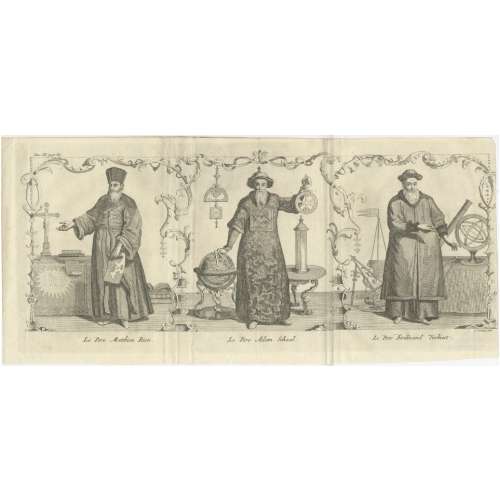
Three priests: Le Pere Matthieu Ricci, Le Pere Adam Schaal, and Le Pere Ferdinand Verbiest. Three priests with navigational instruments. Image taken from Description geographique, historique, chronologique et physique de l'Empire de la Chine et de la Tartarie Chinoise. Enrichies des cartes generales et particulieres de ces pays, etc. by Jean-Baptiste Du Halde (1674–1743), vol. 3, page 78. Originally published/produced in La Haye [The Hague], 1736. J.v.Solingen fecit
Jean-Baptiste Du Halde (Chinese: 杜赫德; 1 February 1674 – 18 August 1743) was a French Jesuit historian specializing in China. He did not travel to China, but collected seventeen Jesuit missionaries' reports and provided an encyclopedic survey of the history, culture and society of China and "Chinese Tartary," that is, Manchuria. Voltaire said of Du Halde's work: "Although it is developed out of Paris, and he hath not known the Chinese, [he] gave on the basis of the memoirs of his colleagues, the widest and the best description the empire of China has had worldwide." Le Pere Matthieu Ricci, a.k.a. Matteo Ricci, S.J. (Italian pronunciation: [matˈtɛːo ˈrittʃi]; Latin: Mattheus Riccius Maceratensis; 6 October 1552 – 11 May 1610), was an Italian Jesuit priest and one of the founding figures of the Jesuit China missions. His 1602 map of the world in Chinese characters introduced the findings of European exploration to East Asia. He is considered a Servant of God by the Roman Catholic Church. Ricci arrived at the Portuguese settlement of Macau in 1582 where he began his missionary work in China. He became the first European to enter the Forbidden City of Beijing in 1601 when invited by the Wanli Emperor, who sought his services in matters such as court astronomy and calendrical science. He converted several prominent Chinese officials to Catholicism, such as Xu Guangqi, who aided in translating Euclid's Elements into Chinese as well as the Confucian classics into Latin for the first time. Le Pere Adam Schaal, a.k.a. Johann Adam Schall von Bell (1 May 1591 – 15 August 1666) was a German Jesuit and astronomer. He spent most of his life as a missionary in China (where he is remembered as "Tang Ruowang") and became an adviser to the Shunzhi Emperor of the Qing dynasty. Le Pere Ferdinand Verbiest, a.k.a. Father Ferdinand Verbiest (9 October 1623 – 28 January 1688) was a Flemish Jesuit missionary in China during the Qing dynasty. He was born in Pittem near Tielt in the County of Flanders (now part of Belgium). He is known as Nan Huairen (南懷仁) in Chinese. He was an accomplished mathematician and astronomer and proved to the court of the Kangxi Emperor that European astronomy was more accurate than Chinese astronomy. He then corrected the Chinese calendar and was later asked to rebuild and re-equip the Beijing Ancient Observatory, being given the role of Head of the Mathematical Board and Director of the Observatory. He became close friends with the Kangxi Emperor, who frequently requested his teaching, in geometry, philosophy and music. Verbiest worked as a diplomat and cartographer, and also as a translator because he spoke Latin, German, Dutch, Spanish, Hebrew, and Italian. He wrote more than thirty books. During the 1670s, Verbiest designed what some claim to be the first ever self-propelled vehicle – many claims this as the world's first automobile, in spite of its small size and the lack of evidence that it was actually built.Joshua Van Solingen was an engraver and publisher from Holland, working, besides other places, in Scotland. Information about him can be found at Catastrophic Bliss (The Griot Project Book Series) by Accounting in Scotland (RLE Accounting): A Historical Bibliography History of the Scottish Metrical Psalms: With an Account of the Paraphrases ... The History of Edinburgh, from the Earliest Accounts to the Present Time ... History of the Bassandyne Bible, the First Printed in Scotland: With Notices ...
-
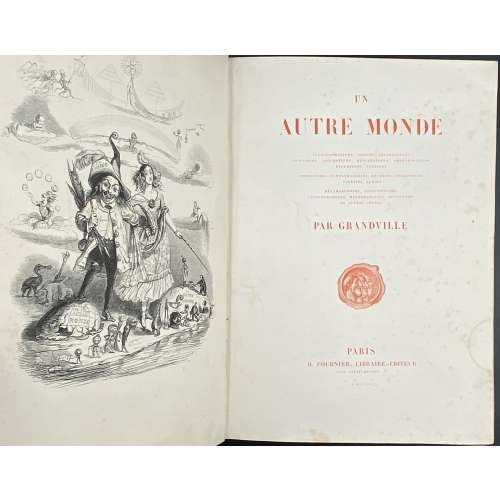 Description: One volume, collated 4t0, 27.3 x 20 cm, bound in contemporary quarter black chagrin, gilt ornaments and lettering to spine (reliure à l'époque romantique), marbled end-papers; printed on wove paper (vélin fort). Title-page (red): UN | AUTRE MONDE | TRANSFORMATIONS, VISIONS, INCARNATIONS | ASCENSIONS, LOCOMOTIONS, EXPLORATIONS, PÉRÉGRINATIONS | EXCURSIONS, STATIONS || COSMOGONIES, FANTASMAGORIES, RÈVERIES, FOLATRERIES | FACÉCIES, LUBIES || MÉTAMORPHOSES, ZOOMORPHOSES | LITHOMORPHOSES, MÉTEMPSYCHOSES, APOTHÉOSES | ET AUTRES CHOSES | PAR GRANDVILLE | [device] | PARIS | H. FOURNIER, LIBRAIRE-ÉDITEUR | RUE SAINT-BENOIT, 7 | M DCCC XLIV Pagination: ff, [2] half-title in red / imprim., [2] blank / frontis. in black, [2] title page in red / blank, [1] 2-295, [1] explication and erratum, bf, illustrations. Collation: 4to, (1)-(37)4 with frontispiece, 133 woodcut vignettes, 15 full-page black woodcuts, and 36 hand-coloured plates. Catalogue raisonné: Carteret (p. 285) describes the book as 'in-8', but the collation is actually in quarto (in-4, or 4to) with series signed in Arabic numerals. Ray (French): p. 275-7. The publication is anonymous, however, Grandville reveals the author's name (that's Taxile Delord) on the vignette on p. 292 at the bottom of the plate (under ICI).
Description: One volume, collated 4t0, 27.3 x 20 cm, bound in contemporary quarter black chagrin, gilt ornaments and lettering to spine (reliure à l'époque romantique), marbled end-papers; printed on wove paper (vélin fort). Title-page (red): UN | AUTRE MONDE | TRANSFORMATIONS, VISIONS, INCARNATIONS | ASCENSIONS, LOCOMOTIONS, EXPLORATIONS, PÉRÉGRINATIONS | EXCURSIONS, STATIONS || COSMOGONIES, FANTASMAGORIES, RÈVERIES, FOLATRERIES | FACÉCIES, LUBIES || MÉTAMORPHOSES, ZOOMORPHOSES | LITHOMORPHOSES, MÉTEMPSYCHOSES, APOTHÉOSES | ET AUTRES CHOSES | PAR GRANDVILLE | [device] | PARIS | H. FOURNIER, LIBRAIRE-ÉDITEUR | RUE SAINT-BENOIT, 7 | M DCCC XLIV Pagination: ff, [2] half-title in red / imprim., [2] blank / frontis. in black, [2] title page in red / blank, [1] 2-295, [1] explication and erratum, bf, illustrations. Collation: 4to, (1)-(37)4 with frontispiece, 133 woodcut vignettes, 15 full-page black woodcuts, and 36 hand-coloured plates. Catalogue raisonné: Carteret (p. 285) describes the book as 'in-8', but the collation is actually in quarto (in-4, or 4to) with series signed in Arabic numerals. Ray (French): p. 275-7. The publication is anonymous, however, Grandville reveals the author's name (that's Taxile Delord) on the vignette on p. 292 at the bottom of the plate (under ICI).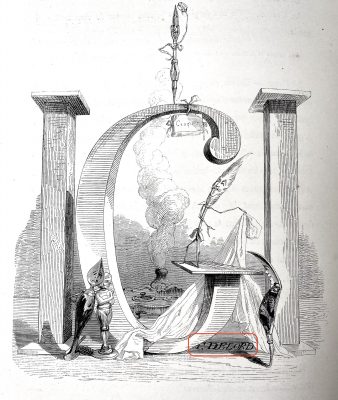
-
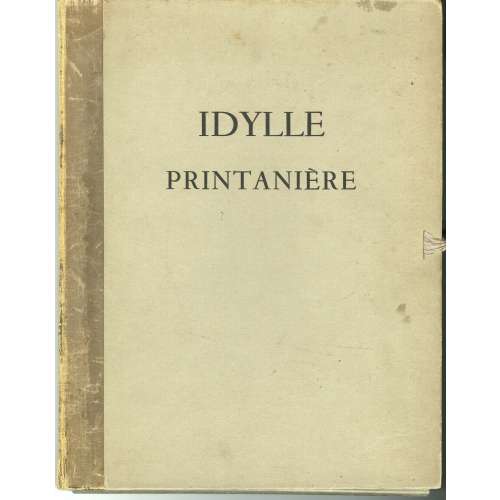 Title: IDYLLE | PRINTANIÈRE || Verso: {Headpiece} | Justification du tirage | {7 lines of text} | Exemplaire № 56 (digits by hand) | HP (monogram by hand) | {tailpiece} || Album of 30 hand-coloured lithographs and frontispiece in a cardboard folder; each sheet mounted in a 32.5 x 25 cm passepartout with 19 x 13 cm window; published in Paris in 1938 by Henri Pasquinelli (attributed). No artist, no publisher name indicated. According to Justification du tirage, the print run of 516 copies on Arches laid tinted paper (vergé), copy A – control artist’s uncoloured, 15 copies B–P reserved for collaborators and friends, copies 1–500 – for bibliophiles. This copy № 56, autographed by the publisher's monogram: "HP". Catalogue Raisonné: J.-P. Dutel, vol 2 (1920–1970), #1726, p. 207-8. Provenance: J.-P. Dutel.
Title: IDYLLE | PRINTANIÈRE || Verso: {Headpiece} | Justification du tirage | {7 lines of text} | Exemplaire № 56 (digits by hand) | HP (monogram by hand) | {tailpiece} || Album of 30 hand-coloured lithographs and frontispiece in a cardboard folder; each sheet mounted in a 32.5 x 25 cm passepartout with 19 x 13 cm window; published in Paris in 1938 by Henri Pasquinelli (attributed). No artist, no publisher name indicated. According to Justification du tirage, the print run of 516 copies on Arches laid tinted paper (vergé), copy A – control artist’s uncoloured, 15 copies B–P reserved for collaborators and friends, copies 1–500 – for bibliophiles. This copy № 56, autographed by the publisher's monogram: "HP". Catalogue Raisonné: J.-P. Dutel, vol 2 (1920–1970), #1726, p. 207-8. Provenance: J.-P. Dutel.



